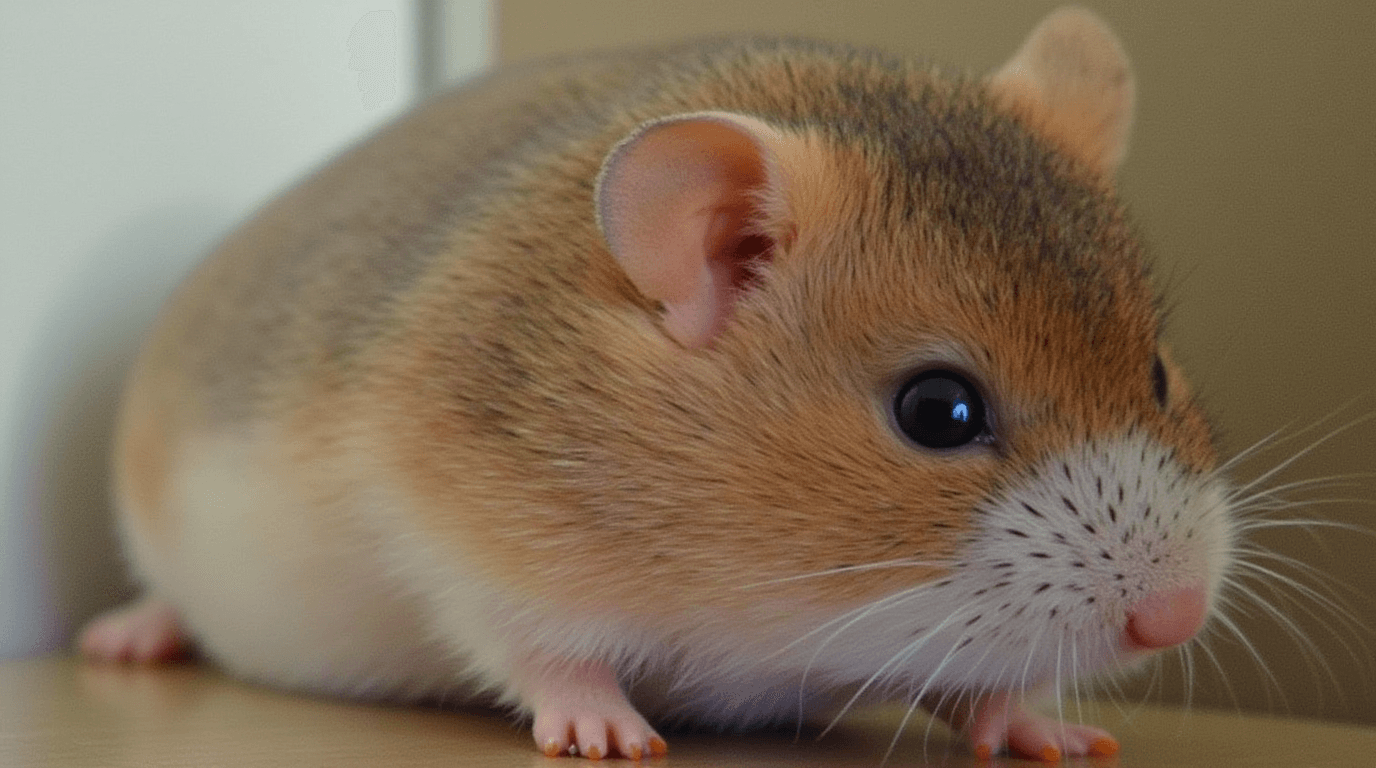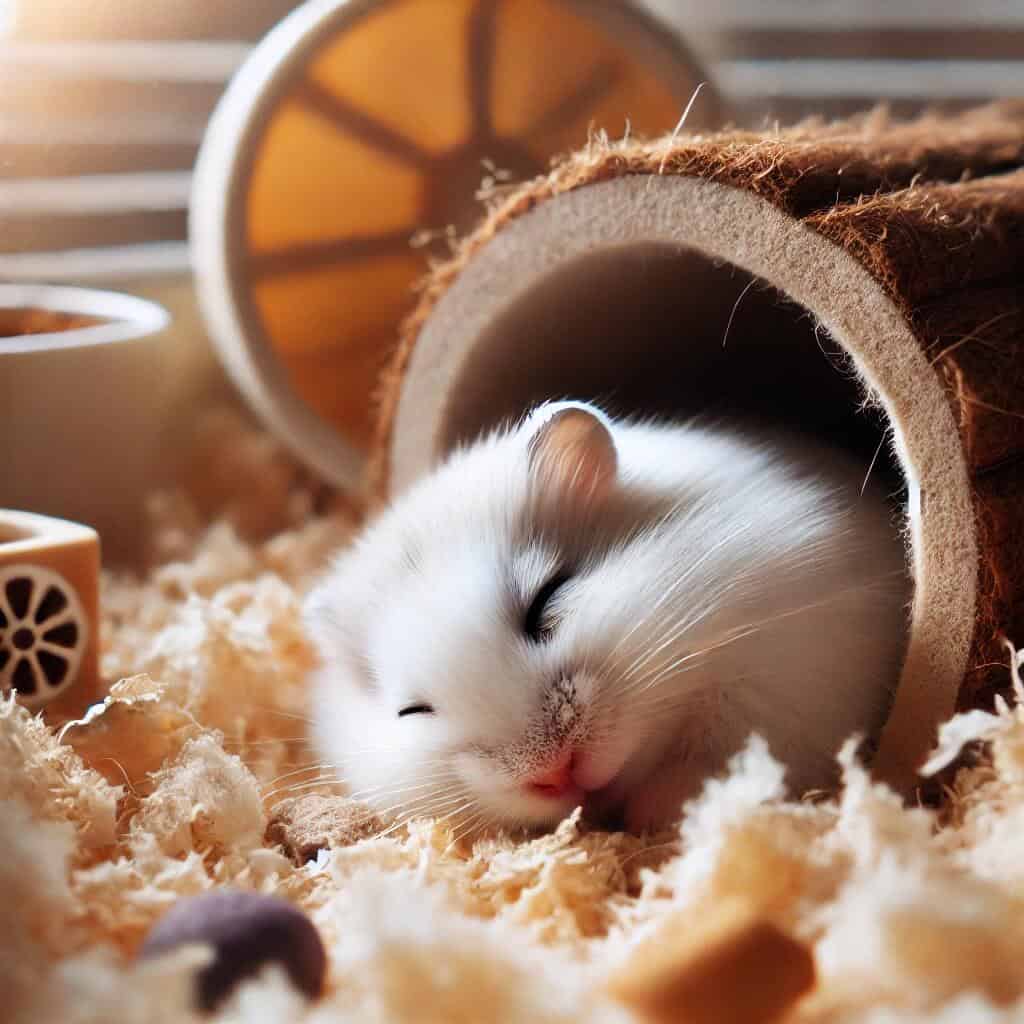Introduction:
Hamsters are known for their adorable, fluffy appearance and lively behavior. But if you’ve ever noticed your hamster appearing unusually flat, you might wonder if something’s wrong. The “flat hamster” phenomenon is more common than you may think, and understanding why it happens can help ensure your pet’s well-being. This article will explore why hamsters may get flat, discuss different hamster breeds, and answer some commonly asked questions about their behavior and care.

Why Does My Hamster Get Flat?
Hamsters flatten their bodies for various reasons, and it’s usually linked to natural behaviors. When lying down, stretching, or feeling scared, a hamster may spread its body out to stay hidden. This is an instinctual survival response, helping them avoid potential predators in the wild. Flattening can also occur during sleep when they relax completely.
In some cases, a hamster appearing flat could indicate stress or an underlying health issue. When in distress, a hamster might flatten itself to feel secure. If your hamster consistently shows signs of flattening along with unusual behaviors like decreased appetite, excessive hiding, or lethargy, it’s a good idea to consult a veterinarian.
Another reason a hamster might appear flat is when they squeeze into tight spaces. Hamsters are known for their burrowing instincts, and this behavior can often make them look flattened as they wiggle through narrow gaps.
Natural Behaviors and Habits
Hamsters exhibit many behaviors that could make them look flat. For instance, when burrowing or grooming, their bodies can appear more elongated and closer to the ground. It’s also common for hamsters to lie flat in their habitat if they’re feeling particularly comfortable. After all, these little rodents have a way of making themselves as cozy as possible.
In addition to natural behaviors, temperature can influence how a hamster lies. When it’s warm, they may spread out to cool down, whereas in colder temperatures, they might curl up to conserve heat. Understanding your hamster’s body language in different contexts can provide insights into its comfort level.
Health Issues to Watch For
While flattening is often a normal behavior, it can sometimes be a symptom of a health concern. Conditions such as respiratory infections, digestive issues, or even injuries could cause a hamster to lie flat more frequently. Respiratory problems might make breathing difficult, leading a hamster to flatten itself to rest more comfortably.
If you suspect your hamster is flattening due to illness, check for other signs like sneezing, discharge, or labored breathing. Consulting a vet is crucial to ensure that your pet is not suffering from a serious condition.
What is the Smallest Type of Hamster?
The Roborovski hamster is the smallest hamster breed, often growing to only 4–5 centimeters in length. Known for their tiny size and speedy movements, Roborovski hamsters are also quite agile. Despite their small stature, they have a big personality and can be very active in their cages.
These hamsters typically weigh around 20-25 grams, making them significantly smaller than larger breeds like the Syrian hamster. Their petite size means that extra care should be taken when handling them, as they can be fragile and quick to escape.
Size Comparison
To put the Roborovski hamster’s size into perspective, let’s compare it with some other hamster types:
- Syrian hamster: The largest breed, measuring 15–18 centimeters in length and weighing around 120-150 grams.
- Dwarf Campbell’s Russian hamster: Typically 8–10 centimeters long, weighing about 30-50 grams.
- Chinese hamster: Slightly longer than the average dwarf hamster, with a body length of 10–12 centimeters and a weight of 30-45 grams.
The Roborovski’s small size and energy make them a delight to watch but a challenge to tame, especially for first-time hamster owners.

Is a Syrian a Dwarf Hamster?
No, the Syrian hamster is not considered a dwarf hamster. While dwarf hamsters are characterized by their small size, Syrian hamsters are much larger. Often called “teddy bear” hamsters due to their size and fur type, they are the most commonly kept pet hamster. Their larger size also makes them easier to handle, especially for children or beginner pet owners.
In contrast, dwarf hamsters include breeds such as the Campbell’s Russian, Winter White, and Roborovski hamsters. They tend to be smaller and more active, which can make them a bit more challenging to tame. While both dwarf and Syrian hamsters can make wonderful pets, their care requirements differ, particularly regarding space and handling.
Differences in Size and Behavior
Syrian hamsters generally have a calmer demeanor compared to dwarf species. They are solitary animals, meaning they should be kept alone, as housing multiple Syrians together can lead to aggression. Dwarf hamsters, on the other hand, can sometimes be housed in pairs or small groups, depending on the breed.
Behaviorally, dwarf hamsters are more energetic and may be more prone to biting if they feel threatened. Understanding these distinctions helps ensure that owners provide the appropriate care based on the hamster’s type.
What is the Most Peaceful Hamster?
When choosing a hamster known for its gentle nature, the Syrian hamster is often considered the most peaceful. Due to their calm temperament, Syrians are generally easier to tame and handle. They are less likely to nip compared to dwarf breeds and tend to be more affectionate with their owners.
However, this doesn’t mean dwarf hamsters can’t be friendly. The Winter White dwarf hamster, in particular, is known for having a more laid-back and social personality compared to other dwarf breeds. While they are still more active than Syrians, they can bond well with their owners if given proper time and attention.
Tips for Socializing Your Hamster
To encourage gentle behavior, it’s essential to spend time handling your hamster every day. Start by offering treats to create a positive association with your hand. Gradually increase the duration of handling sessions while ensuring the hamster feels secure. Avoid waking them up suddenly or handling them when they seem nervous, as this can lead to biting.
Hamsters also respond well to consistency. Keep their environment stable and introduce changes gradually to avoid stress. Providing toys, tunnels, and hideouts will encourage natural exploration and help them feel safe.
Common Health Concerns and Hamster Behavior
Hamsters are generally hardy pets, but they can still experience health problems. Conditions like wet tail, respiratory infections, and mites are among the common issues affecting hamsters. Stress-related behaviors, such as excessive flattening, hiding, or changes in appetite, could signal a problem.
Identifying Signs of Stress or Illness
Symptoms of illness may include labored breathing, weight loss, lethargy, or unusual discharge. If you notice these symptoms along with frequent flattening, seek veterinary advice. Regular check-ups and preventive care can help catch potential problems early.
Preventive Care Tips
Maintaining a clean and spacious environment for your hamster reduces the risk of health problems. Ensure they have a balanced diet rich in fresh vegetables, high-quality hamster pellets, and occasional treats. Freshwater should always be available, and their bedding should be changed frequently.
Handling your hamster gently and allowing them plenty of exercise outside their cage also contributes to their well-being. Monitoring their behavior and acting on any unusual changes will help keep your furry friend healthy.

Conclusion
Understanding why your hamster may appear flat is an important aspect of their care. Whether it’s due to natural behaviors, environmental factors, or potential health issues, observing your hamster closely will help you determine the cause. Remember to consider their breed when it comes to temperament and size, as these factors play a role in their behavior.
If you notice persistent changes in your hamster’s behavior, it’s always best to consult a veterinarian. Your efforts in providing a healthy, engaging environment will ensure your hamster lives a happy and comfortable life.
Encourage your hamster’s natural behaviors while maintaining a watchful eye, and don’t hesitate to seek professional advice when needed. Share your own hamster experiences with the community and help others learn how to keep their little companions thriving!
FAQ:
Why is my hamster so flat?
A Flat Hamster may simply be stretching or resting in a relaxed position, especially if they feel safe and comfortable. However, it could also indicate overheating or illness. Ensure their environment isn’t too warm and monitor their behavior. Persistent flatness may warrant a check-up with a veterinarian to ensure health.
How to get a flat hamster?
To see a Flat Hamster, create a calm and comfortable environment. Hamsters flatten themselves when they feel relaxed or are cooling off. Provide a clean habitat, cozy bedding, and optimal temperatures. Avoid loud noises or disturbances. A happy, stress-free hamster often exhibits this adorable, flattened posture naturally.
Are dwarf hamsters nice?
Dwarf hamsters are generally friendly and engaging pets. While they are smaller and more energetic than larger breeds, they can form bonds with consistent, gentle handling. Unlike a Flat Hamster, which may exhibit calm behavior, dwarf hamsters are lively and curious, making them delightful companions for attentive owners.
How long do happy hamsters live?
Happy hamsters typically live 2-3 years, though some may reach 4 with excellent care. A stress-free environment, nutritious diet, and regular interaction contribute to their longevity. Unlike a Flat Hamster resting in comfort, a healthy hamster remains active and curious, enjoying a fulfilling life with attentive owners.
Which hamster is most friendly?
Syrian hamsters are widely regarded as the friendliest, making them ideal for beginners and families. Their larger size and calm demeanor make them easy to handle and bond with. Unlike a Flat Hamster, which relaxes quietly, Syrian hamsters enjoy interaction and can form affectionate relationships with their attentive caregivers.
What does an unhappy hamster look like?
An unhappy hamster may display lethargy, excessive hiding, or signs of stress like bar-chewing or pacing. Unlike a relaxed Flat Hamster, an upset hamster might appear tense or overly alert. Poor grooming and a lack of appetite can also indicate unhappiness, highlighting the need for a comfortable and engaging environment.
Are hamsters intelligent?
Hamsters are surprisingly intelligent for their size. They can navigate mazes, remember routines, and even recognize their owners over time. Unlike a Flat Hamster resting peacefully, their inquisitive nature drives them to explore and solve problems. Providing mental stimulation keeps these clever pets engaged and enhances their overall well-being.
What is the most common cause of death in hamsters?
The most common cause of death in hamsters is age-related health issues, including organ failure and tumors. Poor diet, stress, or improper care can also lead to premature death. A Flat Hamster posture may indicate illness or extreme fatigue, warranting immediate attention to ensure their health and longevity are preserved.
Does my hamster get bored?
Yes, hamsters can get bored without sufficient stimulation. Signs include lethargy, repetitive behaviors, or chewing on bars. Unlike a relaxed Flat Hamster, boredom can lead to stress and health issues. Providing toys, tunnels, and a spacious habitat keeps your hamster engaged, ensuring their physical and mental well-being is maintained.
Share your thoughts in the comments below! If you enjoyed this post, consider subscribing to our newsletter for more pet tips, stories and blogs!
